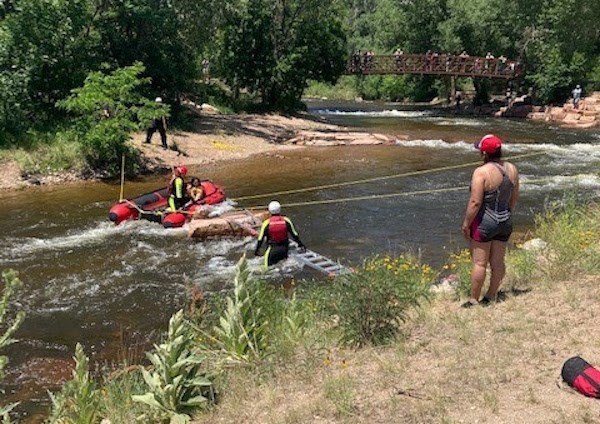When the inevitable water rescue calls come in, rescue agencies must be ready. That's why swiftwater rescue instructors and trainees, are swarming Clear Creek in and around this city with a strong river and plenty of recreational visitors.
Dive Rescue International hosted trainees from local and out-of-state departments. Golden's fire department and West Metro Fire Rescue conducted internal training sessions.
The water’s been too high and fast for most this month, but rescuers train in these conditions so they’re prepared for the worst, Golden’s Lt. Marc Staley explained. The run-off season typically lasts about a month and Clear Creek has become a hotspot because of its trail access and water features.
Golden trained five swiftwater rescue swimmers in early June. They first practiced how to rescue themselves should they be swept into raging waters. Then they focused on saving others. They used various combinations of gear and worked on establishing rope lines across the creek, escaping debris in the water.
According to Staley, less than a quarter of Golden’s firefighters are trained in swiftwater rescue.
It’s a similar story at West Metro, where only 25-30 of its 400-plus firefighters are trained in swiftwater rescues. Typically, only those assigned to Stations 8 and 17 undergo the training. Station 8 includes the West Metro Dive Team and Station 17 is near Wheat Ridge's section of Clear Creek.
West Metro hosted internal Swiftwater rescue classes for seven trainees. Their final search and rescue exercise, which was June 9 near Clear Creek Canyon’s Tunnel 1, required them to get a raft across the creek to save a stranded person, and then conduct a shoreline search.
Lead instructor Dave Dame emphasized how physically demanding the training is, as Clear Creek was moving around 1,000 cubic feet of water per second during the training. Year-round, the creek ranges from 300-1,600 cubic feet per second, with June seeing the highest, most hazardous volumes.
In terms of speed, the water was moving about 15 mph, Dame estimated. While that doesn’t seem fast compared to a car, he stressed the speed is “much faster than you can swim.” Plus, water temperatures are so low, people without proper gear can become hypothermic very quickly, he said.
Staley and Joe Gross, a GFD battalion chief, said they’ve fielded dozens of water rescue calls in their combined 26 years as rescue swimmers. They said too many people visit Clear Creek with a “water park mentality,” and don’t realize how dangerous the sheer volume of water can be.
“By the time they realize they need help, it’s too late,” Gross said. “There are sections of the river that even we won’t swim.”
Gross also emphasized how even rescuers need to have a healthy respect for the creek, because it’s unlike firefighters’ usual training environments. When they train to put out fires or go into burning buildings, their scenarios are controlled. Clear Creek is not.
However, Staley said, that while they can’t control the creek, it can become more predictable through their training.
Still, many who initially train in swiftwater rescue don’t feel comfortable retraining. Gross and Staley said being in the creek is exhausting, so GFD only wants those who are comfortable and prepared to do it.
Inevitably, each year there are a dozen or so rescue calls from late spring through the summer, Staley said. Two people died in creek-related accidents last year, and rescuers don’t want to see any more.
Staley also predicted Clear Creek could run higher than normal for the next few weeks. If so, the current red-flag restrictions could be extended into the typical tubing season.
Prospective creek users should pay attention to the flag warning status and all signage before getting in the water, and wear personal flotation devices.
While Golden, West Metro and other rescuers are prepared for the worst, they hope it never comes.



